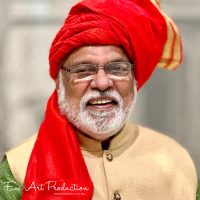Editorial September 2023
| Dear Readers,
Once again, we are very happy and proud to bring you another special edition on South Asian weddings. In this editorial, I want to talk more about the sacred role of Hindu scriptures in the Hindu wedding ceremony. Let us look at the influence of Hindu scriptures on Hindu weddings. The Vedic Influence The Vedas are perhaps the most ancient religious scriptures in the world, and they play a significant role in shaping the structure of a Hindu wedding. One of the key rituals is the Saptapadi,” or Seven Steps, where the couple takes seven steps around the sacred fire, each representing a vow or a prayer for their life ahead. This ritual is mentioned in the Rigveda, and each step is a solemn commitment to uphold values like love, trust, and loyalty. In many ways, the fire itself is a Vedic element, considered a witness to the vows, underscoring the sanctity and seriousness of the commitment being made. Philosophy from the Upanishads and the Bhagavad Gita While the Vedas provide the procedural roadmap for the ceremony, the Upanishads and the Bhagavad Gita offer philosophical wisdom that outlines the spiritual significance of marriage. In the Bhagavad Gita, the concept of “Dharma,” or righteous duty, plays a pivotal role. Marriage is seen as a partnership where both individuals work towards fulfilling their Dharma, both towards each other and the community at large. The Scriptural Tapestry It’s not just the couple that turns to Hindu scriptures during this life-altering event; their families do too. The elders often recite verses and chant mantras from these scriptures as blessings, providing a source of spiritual strength and guidance for the couple. Scriptures are also recited to invoke the gods and goddesses of Hindu mythology, asking for their blessings for a harmonious and prosperous married life. Beyond Rituals: Lifelong Lessons The role of Hindu scriptures in a Hindu wedding extends far beyond the ceremony itself. They offer a blueprint for a balanced, harmonious life. These texts emphasize the significance of virtues like patience, kindness, and selflessness, encouraging couples to embody these values throughout their marital journey. Modern Hindu couples need to read these scriptures together, finding in them a constant source of inspiration and guidance. The cultural and spiritual symbiosis In the 21st century, as cultures meld and traditions evolve, many Hindu couples are opting for a blend of modern and traditional practices in their wedding ceremonies. However, even in the most contemporary settings, the essence of the rites—driven by the wisdom found in ancient scriptures—remains unchanged. The Fabric of Rituals From the joyous Sangeet and Mehendi ceremonies to the spiritual core of the Seven Pheras, each ritual in a Hindu wedding is imbued with symbolic meanings and teachings. Hindu scriptures are not just ancient texts but living traditions that breathe life into one of the most important social institutions in Hindu culture. They offer more than just a set of rituals; they provide a comprehensive spiritual, ethical, and philosophical framework for a life built on mutual respect, love, and shared responsibilities. By closely aligning the wedding ceremony with these age-old texts, Hindu culture ensures that each marital union is not just a social contract but a sacred covenant. The essence of a Hindu wedding remains the same: a sanctified bond that goes beyond the wedding attire, the glitz of the jewelry, or the grandeur of the celebrations. It’s a spiritual and emotional union that transcends earthly limitations, an amalgamation of two souls in the quest for love, companionship, and a shared future. Hindu weddings are a beautiful amalgamation of the past and the present, tradition and modernity, individuality and community. As we look forward to another year of love and unions, let us celebrate not just the resilience of our traditions but also the adaptability and dynamism that make Hindu weddings truly unique. Regional Diversities Celebrated One of the most beautiful aspects of Hindu weddings is their regional diversity. In recent years, there has been an increasing trend to incorporate rituals from both the bride’s and groom’s cultural backgrounds, especially in inter-state or inter-caste marriages. This brings a fascinating blend of traditions under one roof. The Blend of Old and New In today’s digitized age, technology has not spared the wedding sector. Drone photography, live streaming, and virtual reality experiences are augmenting the wedding experience. But technology isn’t overshadowing tradition; it’s enhancing it. For instance, many families now use custom apps to share folklore, traditions, and the history behind rituals with guests. So, whether you’re planning a wedding or simply dreaming about one, know that the Indian wedding landscape is expansive and inclusive, allowing you to be as traditional or as modern as you wish. And that’s something worth celebrating. As we celebrate another wedding season, let us appreciate the beautiful fusion of tradition and modernity that is the Hindu wedding, an ever-evolving expression of love, devotion, and community. And speaking of Hindu culture and heritage, Desh Videsh Media Group and ACE DJ are hosting the largest event of its kind, Live Raas Garba from Khelaiya Group, one of the most popular Live Raas Garba from Mumbai, India. This is the group that came out with the first non-stop Raas Garba CD in the industry.
Until then, be safe and be happy! Raj Shah |






























